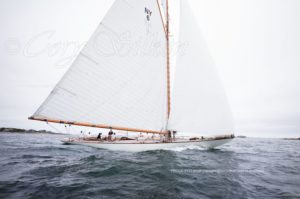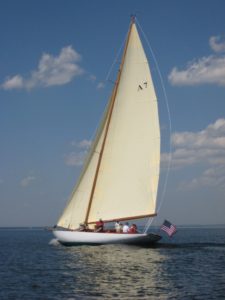
So far, 43 boats have entered this years Camden Classics all with great backstories.
The 2019 Camden Classics Cup is almost making us wish there was legal sports betting in sailing!
We got a chance last week to review the scratch sheet for this summer’s celebration of contemporary, classic and modern-classic yachting in the heart of lovely Penobscot Bay, Maine. And this still-growing fleet of 43 boats is chock full of competitive classes, great backstories and larger-than-life characters.
The eye-popper class in this year’s Camden Classics is the 9-boat, Vintage Division 1. The entry here that you can’t help but gawk at is Spartan, the beautifully-restored Herreshoff NY50 that’s been burning up the race courses in the Med for the last couple of years, or so. And oh, does the 72-foot Spartan tell a big story. She’s one of the original 9 NY50’s built by the New York Yacht Club as a kind of uber-daysailer, back in the single winter of 1912. After more than a century only Spartan and maybe another NY50 christened Barbara, survive. But after a dismasting and lots of foolishness involving poor maintenance, Spartan had fallen on hard times. Until she was restored to her original glory starting in 2006 by MP&G Yard in Mystic, Connecticut. Herreshoff himself would not have recognized the upgraded Spartan. Everything from the mast hoops to the deck furniture was brought to top trim, with towering spars built by our friends and neighbors here in Belfast, French and Webb.

The fully-powered Spartan, flashing her massive boom that’s longer than most other boats entered in the regatta.
But the varnish and fussy details should not mar the serious racing pedigree of Spartan. She carries 50 feet of waterline, 14’-7” of beam, 9’-9” of draft and a ludicrously large sail plan. The huge gaff-rigged main features a boom longer than most of the other boats in the regatta. The sail shows almost 2,000 square feet of canvas. Don’t forget, that there’s an additional 450 square-foot (!) of main topsail, with yards that are longer than the spars on a J-24.
Dealing with Spartan’s mainsheet is worth spending a moment to quantify. It looks like the attachment point is about 40 feet aft of the mast, with a six-part, double-ended mainsheet. Assuming the boom is let out 90 degrees before the stopper knots come up against the blocks, that means the sheet has to be at least 1.4 times that 40 feet length of the boom. And the line has travel 6 trips through the blocks, for a total mainsheet length of 336 feet!
Certainly, with the double-ended sheet, you could pull both ends in a gybe to get the the boom moving faster, with a 3-to-1 effective purchase. But still, it takes a team of trained sailors pulling and easing 170 feet of line on each end to gybe this boat without incident. And crash gybing Spartan would send serious hardware flying around above your head!
The impact concussions would be straight out of Saving Private Ryan. Gybing this boat is what they hire the professional crews to do!
A Speedy Buzzard’s Bay
Much more subtle — and interesting to our design eye — is Mashnee. She’s a Buzzards Bay 30 lovingly restored in Vermont by Windfall Woodworks. We give a lot of credit to Windfall for crafting an authentic restoration that still found plenty of ways to sensibly innovate. Built in 1902, Mashnee was drawn with the classic NG Herreshoff underbody that features a shallow-ballast keel and a big centerboard. Original Buzzards Bay 30s had huge gaff mainsails, with a double-head rig on a long bowsprit. In her restoration, Mashnee was given a new rig designed by Doug Hylan. It’s a tall, elegant Marconi sloop affair that wouldn’t have been out of place on NG Herreshoff’s later sailboats or even on his son Sidney DeWolfe Herreshoff’s designs from the 1930’s.

The lovely Mashnee is a Buzzards Bay 30. Not ‘in’ the period — but still fast — bowsprit!
We particularly like how Mashnee still carries a period bowsprit, but it’s used these days only for setting big drifters or downwind asymmetrical spinnakers. That’s innovation within tradition. We love it.
Mashnee is a good boat, with big speed potential. She is now part of Herreshoff’s alma mater MIT’s sailing program. The smart money says she’ll give the big boats, like The Blue Peter a run for its money. The Blue Peter is a gorgeous Alfred Mylne design, with a towering sloop rig. We also like Silent Maid, a cool classic catboat with a varnished hull and super-peaked-up gaff rig. The rig is so tall that the boat is almost a gunter, but more efficient. Silent Maid is usually sailed aggressively — and very successfully — with lots of crew on the rail.
We would not be surprised if one of these smaller classics takes out Spartan on corrected time.
What’s Hot in the Spirit-of-Tradition.
Another division worth a look will be the Spirit of Tradition class that will feature 4 boats in the 45-foot-to-50-something-foot range: Lynnette, Vortex, Blackfish, and Dreadnought. Those boats are shaping up to be a hard fight in that size range.
Blackfish and Dreadnought are near-sister Jim Taylor designs that feature the same hull but slightly different layouts. Lynnette is an Eggemoggin 47, a design that originated while Bob Stephens worked for Brooklin Boat Yard, with updated and fast foils from Jim Taylor. And the redoubtable Vortex, a Swede 55 sailed by Steve White, has proven her mettle over almost three decades of racing. All fast and well-sailed boats. And of course, our new 65 foot daysailer boat Anna will be looking to improve upon her second-place finish from last year, especially against Blackfish, who nipped her by only two seconds in the 2018 running of the Eggemoggin Reach Regatta.
Toss in what amounts to two major one-design events — the 8-boat J/46 class and the growing Dolphin daysailer class — and there won’t be any shortage of gentlemen’s betting going on in this year’s Camden Classics Cup.
Speaking of which, do we have any gaming and gambling attorneys reading? If so, could you fill us in on the legalities of real wagering in sailing. Sports betting it is legal now in many states, and we would be happy to make a line on this year’s regatta. We just don’t know how!
The racing will be that good!